You are entitled to your own opinion. But you are not entitled to your own facts.
--Daniel Patrick Moynihan

That's a good motto to live by. And it is how good public officials govern.
Village leaders in Tarrytown, Irvington, Dobbs and Hastings are taking action to make Broadway safer and acessible for everyone. Sleepy Hollow deserves this kind of leadership too.
What Sleepy Hollow had instead was former Mayor Wray blocking plans to create a Route 9 corridor that has better walking, cycling, transit and driving facilities along the whole length of the Village. This page documents 35 things Mayor Wray said on 8 occasions to distract the public from the popular project, then lays out the truth of the matter.
Fortunately, Mayor Wray was voted out of office on March 21, 2023.
A resident wrote the Village of Sleepy Hollow to request implementation of the the Route 9 Active Transportation Project. Specifically, fixing the intersection of Broadway (Route 9) at Bedford Rd (Route 448), which will make it safer for their family to walk to Downtown. Mayor Wray mentioned the letter during the correspondence segment of the 7/27/21 Board of Trustees meeting, and to respond, went on the following rant.
[The plan makes] a bike path diagonally through the intersection, which to me is beyond warped, that anybody would send their kid through the middle of an intersection as busy as that.
What's really warped is people have to drive, walk, cycle and use wheelchairs through this chaotic crossroads right now. And the Mayor has no plan to fix it. The Active Transportation Project will make the intersection safer for everyone. (See the Making Route 9 Safe @ 448 video, right, for more details.)
[It doesn't make] an improvement for [the New Broadway / Broadway] crosswalk other than what's there right now.
The plan proposes several improvements there:
(See the Making Route 9 Safe @ 448 video, right, for more details.)
The walk lights on Bellwood. In order to have a walk light, I think you have to have a traffic light. Umm, so, that means we should be putting in, at our expense, a traffic light a every intersection on Bellwood?
The proposal for Bellwood is crosswalks with yield signs. (See Bellwood video, right.)
Raise your hand if you have ever seen a bicyclist stop at a stop sign.
Keep your eye on the ball... People driving killed 3 folks and injured another 133 in 5 years in Sleepy Hollow. This is the result of bad street designs and lax enforcement. Residents have been highlighting these problems for years, but the Mayor has done little to stop the carnage.
See for yourself in the Wray Ranting video, right, and the video of 227 drivers violating stop signs in an hour.
[The] bike path goes on the school side and ends at Patriots Park and has a crosswalk. How do we do a crosswalk in the middle of Route 9 there? I don't know. But a crosswalk there to a bike path that ends there and picks up on the other side of Tarrytown.
This one is complicated, but stick with us...
The long term goal for Broadway between Beekman Ave and the Tappan Zee Bridge is a 2-way mobility lane on the east side of the street, protected by a barrier.
The Route 9 Project's Steering Committee recommended getting there in phases. The first one would skip the area from Wildey St to Main St, in order to reduce bickering over parking spaces in downtown while providing access to key destinations. (Schools, Warner Library and C-Town from the north. Main St from the South.)
But then Tarrytown's officials (at the time) muddled the plan in many ways. Relevant to this discussion, they chopped off the bike lane from Patriot's Park to C-Town. Fortunately, this can be reversed when the project moves forward.
Even if Tarrytown doesn't budge, adding the mobility lane in Sleepy Hollow is valuable -- providing safe access to the High School, Middle School and John Paulding School. The lane could terminate at the school's driveway (at Depeyster St), which has traffic signals, thus resolving the concern about a "crosswalk in the middle of Route 9."
The Mayors Tarrytown, Irvington, Dobbs Ferry and Hastings-on-Hudson wrote a letter to New York's Governor requesting the DOT move forward with the Route 9 Plan. Sleepy Hollow Trustee Jared Rodriguez requested Mayor Wray sign on to the letter as well during the 7/6/21 Trustee Work Session. Here is the answer the Mayor provided.
I worked with the Committee over the years and our feedback hasn't been incorporated.
Early in the process, the Village Administrator expressed the desire to keep the (then recently painted) turn lanes on Broadway along the Cemetery. And that's what the Committee put in the plan.
Later, when reviewing a draft of the Plan, the Mayor told the group that he "does not want to water down the study" and that the group should make an independent proposal. The Village would then take those recommendations under advisement.
We need to focus on plans we've already drafted. [We want] one lane [in each direction], with turn lanes.
Hold on a second... Every plan the Village drafted up to that point had two lanes in each direction and no turn lanes:
Guess what? The Route 9 Project's proposal actually provides what the Mayor wants. And the Mayor knows it. He's seen the group's drawings. And we've told him about the turn lanes on, let's see... one, two, three, four... occasions.
Even better, the Route 9 Project's proposal adds a protected mobility lane for people cycling/scooting/using wheelchairs/etc, adjusts intersections to enhance crosswalk safety and cut excessive speeds around corners.
I think the [attention] our colleagues from the south are trying to get, we already have through our own efforts. We don't need to get [the DOT] to pay attention to us. We're past that. Our goal is implementation.
1) "Implementation?" Of what? The Village's "plan" at that time was some modest changes to one block of Broadway from Pocantico St to the Old Dutch Church; without significant improvements for people walking or cycling.
Mayor Wray doesn't mention the fact that every block of Broadway in Sleepy Hollow needs safety fixes. And that's exactly what the Route 9 Project will do.1
2) The letter to Governor isn't about getting "attention," it is about getting the project done. It requests the Governor's "support for this project," to get "high-level support and engagement" from the DOT, and a "liaison tasked with helping us through the various processes necessary to build our project."
Guess what? The letter worked! The State DOT is undertaking a preliminary design study.
I don't want any of that to get set aside if they think Sleepy Hollow is part of a different effort moving in a different direction.
The coalition is moving in same direction: creating a safe, cohesive corridor. The independent work Sleepy Hollow has done advances one segment of that. And the coalition's strength can help Sleepy Hollow get that segment over the finish line.
We have a certain amount of momentum already, with the things that we submitted and the people that we've been working with.
The Village had a traffic study completed back in 2016 and the DOT made some preliminary drawings in 2017. Now, four years later, the DOT demanded another traffic study. Momentum? That's a runaround.
In the other four villages participating in the Route 9 Project, their Boards of Trustees passed resolutions saying they are interested in seeing the Project move forward. That happened between June and December of 2019. But Sleepy Hollow sat on this resolution for over a year.
During the 11/3/20 Work Session, Sleepy Hollow Trustee Rachelle Gebler took the initiative to move the resolution forward after hearing how Daniel Convissor was endangered twice by people driving while he was cycling to pick up dinner on his anniversary. Mayor Wray then falsely implied what the Route 9 Plan proposes.
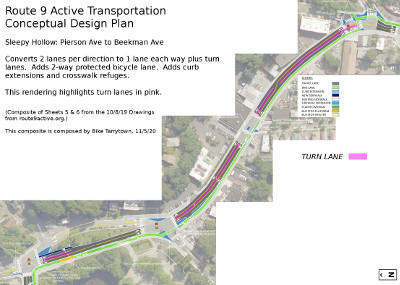
A few years ago [the DOT] finally reduced Route 9 from the Hospital to the Old Dutch Church to two lanes most of the way, and then turn lanes. One of the things that I'd very much like to see is continuing that one lane with turn lanes up to the intersection here at the top of Beekman. The study doesn't really call for some of the same things that we've been advocating.
Uhhh... one lane each way plus turn lanes is what the Route 9 Plan provides between the Old Dutch Church and Beekman Ave. And the Mayor knows it. Upon hearing that, Daniel immediately wrote the Mayor and Trustees to correct the record (with a diagram of this section) and answer some other questions raised.
The Board went on to pass the resolution at the 11/24/20 meeting.
During the public comment period of the 11/26/19 Trustee meeting, three residents expressed their displeasure that the Route 9 Project was removed from the latest draft of the Comprehensive Plan. Bike Tarrytown's Director, Daniel Convissor, also spoke, countering each of the distortions the Mayor made during the 11/5/19 Work Session (details of which are covered in "November 5, 2019" section, below).
Rather than reflect on what was said, the Mayor dug in.
We don't know exactly what recommendations we're endorsing.
The Mayor is deliberately misrepresenting how projects get done.
1) The Route 9 Active Transportation Conceptual Design Plan is done. Period. It shows that the concepts of complete sidewalks, protected micro-mobility lanes, turn lanes, safer intersections, and bus improvements are all possible.
At the same time, it's phase 1 of a long process. Exactly, inch by inch of how to make that happen will be done in the next steps, which are no longer the Conceptual Design Plan.
2) That's the exact process the East Parcel / Commons is using. (An initial round of public outreach helped produce a conceptual design. Now the Local Development Corporation is adjusting the designs and figuring out to actually implement it.) And the Comprehensive Plan specifically endorsed it:
East Parcel -- seek grant funding to implement the Concept Plan, including the bridge over the railroad tracks to connect to the new Edge-on-Hudson development.* (PDF page 138)
* Note: The bridge over the railroad tracks is a horrible idea. It would cut the park in half with a busy road. It'll be a huge expense that further subsidizes driving. And it will induce a lot of driving.
During the 11/5/19 Board of Trustees Work Session, Mayor Wray talked about written public comments received regarding Route 9 Plan in the Comprehensive Plan.
We're not even sure which draft is being presented... [there have been] fairly substantive changes over time.
Comprehensive Plans are about endorsing general concepts (like making Broadway safer for everybody), not providing final sign off on minute details of a huge project.
That said, the Mayor knows what's "being presented." He attended the study's Final Presentation on November 17, 2018, at which he examined the drawings and discussed them.
The current drawings, published October 8, 2019, have two minor tweaks compared to the 2018 version:
PDF Page 3: Removed the crosswalk across Broadway by Phelps Hospital because the consultants drew it in the wrong place. The crosswalk to the Old Croton Aqueduct trail needs to be further north, but that's outside the scope of the drawing.
PDF Page 7: Added a left turn lane from northbound Broadway to Pierson Ave. A left turn facility here was a consistent request of Sleepy Hollow's Steering Committee, but the consultants inadvertently left it off the initial drawings.
It doesn't make sense to have a path that goes from the west side of Route 9 to the east side and then back to the west side of Route 9, within Sleepy Hollow.
The proposed lane changes sides once. North of Beekman Ave the protected mobility lane is on the west side to provide direct connections to:
South of Beekman Ave, the protected mobility lane goes on the east side of Broadway to avoid cross streets, leave parking in place for the homes and offices on the west side, and bring people to and from:
In addition, when the bike lane (eventually) does get built in Tarrytown, it will also be a 2-way lane on the east side of Route 9.
The decision making process was thoroughly explored in the Steering Committee's recommendations and summarized in a presentation to the Board of Trustees on June 19, 2018.
[The lane] ends when you run into Tarrytown because Tarrytown doesn't want a bike lane.
The initial, internal draft proposal by the study's Steering Committee left a gap in the bike lane in Tarrytown between Wildey St and Main St. The goal was to get a base system going that will prove its worth, making it possible to calm the controversy and fill in the gap later.
Tarrytown seems lukewarm about the idea altogether.
Tarrytown's Board of Trustees passed a resolution to support advancing the Route 9 Plan to the next phase.
It's not going to be a continuous bike lane all the way through the other Rivertowns.
Considering how the Sleepy Hollow part of the Route 9 proposal does such a great job of connecting neighborhoods to our key destinations, there's tremendous value in building it even if nobody else does.
It privileges bikes above all other forms of transportation.
The Route 9 Plan is a balanced approach, improving access and safety for everyone by adding:
We, as a Board, know that our responsibility is to cyclists and to pedestrians and to motorists and to our businesses and our residents... That's a balance that we have to consider at all times.
There is no balance on Broadway. It's cars from curb to curb. Several spots don't even have sidewalks. This leaves most residents too scared to bike and wary of walking.
Speaking of the Board's general responsibility to residents, they're failing. The Village allows people to block sidewalks with cars, garbage, and construction. Several proposals to improve pedestrian safety and fix ADA violations have languished. The Beekman Ave Bridge project endangered people walking during construction and the finished bridge has narrower sidewalks. New sidewalks were built without complete crosswalks and yet more disability access violations. Then at the 8/13/19 Trustee Meeting, the Village approved $100,000 to build curbs in Philipse Manor, rather than invest in something that actually matters, like sidewalks to Devries Park and/or Peabody Field.
We wrote an op-ed for the River Journal on how local public policies force people to drive, and some steps to change it.
The publisher gave Mayor Wray of Sleepy Hollow and then Mayor Fixell of Tarrytown the opportunity to write a response. Beside missing the broader policy concerns we raised, their piece is full of holes.
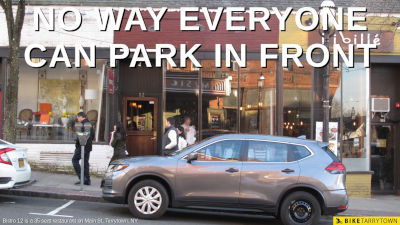
There just is no way to deny that Tarrytown and Sleepy Hollow have parking shortages in our respective downtowns.
Sure, it can be hard to find a parking spot right in front of the store you're going to. That's because cars are big and our downtown stores are small. (Think about it. Most shops are one car wide.)
Let's move beyond anecdotes and look at data. Tarrytown has over 740 spaces in parking lots and 136 curbside parking spaces on Broadway. Half of those spots are empty during peak shopping times. In Sleepy Hollow there were 0 (that's right zero) cars parked on the east side of Broadway.
The problem isn't capacity, it's management. Solutions include smart pricing and letting folks know where available spaces are.
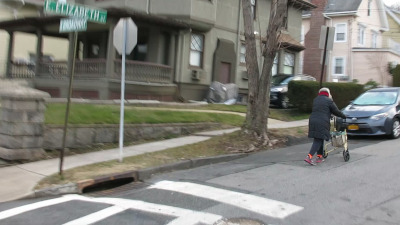
Woman walking in the street with the aid of a walker. They are in the street to avoid a large crack in the sidewalk.
The problem is exacerbated when the weather turns cold and/or wet and is that much worse for those people who are not highly mobile, such as some of our seniors.
That is a textbook case of concern trolling. If the Mayors sincerely cared about the mobility of seniors, we'd see sidewalks: on every street, that are smooth, have ADA curb ramps on each corner, no cars parked on them, ADA accessible bypasses during construction, and they'd be plowed when it snows. This is particularly important, because plenty of old people can't drive.
Our downtown businesses rely in no small measure on customers and clients who do not live within reasonable walking distance of their destinations and homes.
A significant percent of patrons in our villages walk, especially in Downtown Sleepy Hollow.
And our residents who live a little further away are the reason we need to make cycling safe.
By the way, people who shop on foot and by bike spend more money downtown over time.
Much of their business occurs on days and nights when bad weather discourages all but the few hardiest souls from walking or biking.
Sorry. No. Most days here are nice, so that's what we need to plan for.
When we do have bad weather, it nudges people of all sorts to stay home. People who rely on walking and cycling as their primary means of transportation tend to continue doing so regardless of rain or snow. And there are times when driving is nearly impossible, while walking and cycling remain doable.
Mass transit options in Westchester are too limited to offer much relief.
That can be solved by having the Route 13 bus come every 15 minutes.
Folks who say "that's too expensive" need to realize Tarrytown spent $650,000 to build a 25 space parking lot on the west side of Washington St, plus $532,000 to buy 21 spaces behind Citibank. Then add in all the parking lots built along the bus' route through Ossining, Sleepy Hollow, Tarrytown, Greenburgh, Elmsford, White Plains and Port Chester. Good bus service turns out to be a reasonable investment.
In both villages, but especially in Sleepy Hollow, residential parking is at a premium.
That's what happens when things are given away for free.
Instead of worrying about storage for cars, our Mayors need to get out from behind their steering wheels, load up on some empathy, and start caring for people:
We need an equitable transportation system that lifts everyone up by providing safe, affordable transportation options.
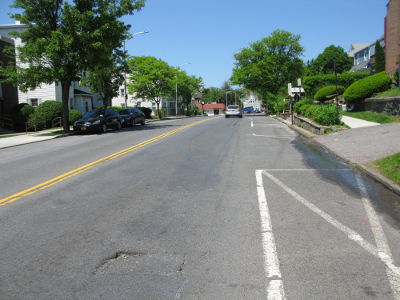
The sidewalk by the Korean Church (right) in Sleepy Hollow is elevated, away from cars on Broadway. Note the vast majority of parking spaces are empty.
Parallel parking on both sides of the street is a necessary component welcoming, successful, and pedestrian-friendly/safer downtowns.
This doesn't apply to the bike lane proposal in Sleepy Hollow. Where there's parking on the east side of Broadway, the sidewalk doesn't exist or is set back from the street.
Let alone, Tarrytown knowingly endangers people walking across Broadway so people driving can save a few seconds. (In particular at Franklin St, Central Ave, and McKeel Ave, where parking is removed so through traffic can go around turning traffic.)
Speck - a cycling advocate
Mr Speck is a walking advocate who's gradually coming around to understanding cycling.
In rare instances, it makes sense to eliminate a flank of parking for a bike lane or transit lane.
The Mayors cherry picked that quote from Jeff Speck's Walkable City Rules.
The next paragraph goes on to say "Most often, though, the proper solution is to create the space for bike and transit lanes by removing not parking lanes, but extra driving lanes." (page 151)
Our cherry picking objection aside, Broadway actually has the conditions that make it one of those "rare instances." We have residential and commercial density, 4 public schools on Broadway and 1 nearby, 5 private (pre)schools, alternative parking locations available, and the Tappan Zee Bridge bike path.
Our downtowns are not one of the rare locations where the comfort of regional commuters should take precedence over local interests.
That quote is rich. Giving commuters precedence is exactly what Tarrytown does. The Village government sacrifices the peace and safety of its own residents (particularly in the in Miller Park neighborhood) for commuters driving to the train station.
The biggest users of safe bike lanes on Broadway will be our own residents. And the people living and working along Broadway will be the biggest beneficiaries of improved access and reduced noise and pollution.
As close monitors of our respective planning efforts know, we have been and are actively pursuing ways to enhance the walkability and bikeability of our villages.
Just stop.
If that were the case, the recent Comprehensive Plans for both villages would contain significant, concrete goals for completing our sidewalk networks, establishing a safe cycling network, and increasing service on the Route 13 bus.
But they don't.
Vague statements calling for sidewalks within 1/4 mile of schools and parks, plus a couple short trails for recreational users doesn't cut it.
In a Journal News article about Tarrytown traffic, when asked about bike lanes on Broadway, he said:
Show me where we have the space to do that.
A team of residents and consultants spent 3 years assembling the Route 9 Active Transportation Plan showing exactly where we have space to do that. And the Mayor has seen the plan.
Daniel Convissor, one of Sleepy Hollow's representatives on on the Route 9 Project's Steering Committee, gave the Board of Trustees an update on the project during at the 6/19/18 Work Session (video, slides). After the presentation, Mayor Ken Wray gave several comments on the topic (at the 1:04:56 mark in the video).
With the protected bike lane, where we have streets that aren't wide enough to actually do something like that.
As the study's drawings show, Broadway is wide enough to include protected mobility lanes.
We need on street car parking because it provides safety for pedestrians. If there's parking, [drivers] slow down, and it presents a barrier that prevents pedestrians from getting hit.
The Mayor rightly mentions how curbside parking can protect people walking. But the parking on Broadway in Sleepy Hollow doesn't actually do that:
1) High School driveway to Korean Church driveway: no sidewalk exists. If a sidewalk is created, it will likely be up the hill, away from the street.
2) At the Korean Church: the sidewalk is elevated, with a planting strip and retaining wall between it and the street
3) From the Korean Church to Tornello's: there's a planting strip with trees between the street and sidewalk
4) At Tornello's and the Horseman Diner: there is no parking along this stretch and the sidewalk is right next to moving cars and trucks
So, the upshot is people walking along segments 1 - 3 don't need parked cars for protection, while in segment 4 implementing a bike lane would create protection.
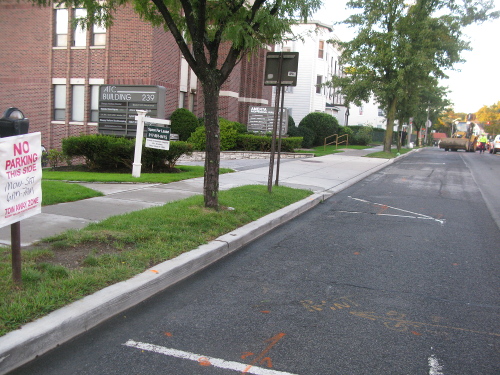
Months of no parking on Broadway due to construction shows how flexible people are when it comes to parking.
I am not in favor of losing the parking spaces we have right now.
Sleepy Hollow is quite lucky when it comes to parking along the Route 9 Project's alignment. On the Village's 2 mile segment, there is only 750' of legal car parking.
In 2018, Con Ed construction on Broadway temporarily eliminated the car parking between Beekman Ave and College St. Sometimes the whole day. Sometimes the whole night. This situation inadvertently provided a real world parking study for us. During this disruption, everybody figured out other places to put their private vehicles. The same will happen once the bike lane is implemented here.
[Bike lanes] may work really well on 6th Avenue, which I'm on all the time, where I'm doing this [looks back and forth] all the time so i don't get clocked by a bicyclist. They tend to go both ways. Bike riders never stop at a stop sign. Bike riders never stop at a red light. You've got to own that.
Finally! Ken reveals what's going on in his psyche. Everything else he says about the Route 9 Project is just cover for this underlying (irrational) bias.
Since he is talking about NYC, let's examine the facts there. People walking are one hundred sixty times more likely to be killed by someone driving than someone cycling.
The Mayor talks about people biking both ways on a 1-way street like it is a problem. 22 years of data shows it is not.
As far as rule breaking, people driving and people cycling do it at the same rate.
Oh, and right after the Mayor implored "you've got to own that," he was asked "do you ever go over the speed limit?" His reply: "yes."
1 The Steering Committee's vision for Broadway in Sleepy Hollow:
See the Committee's report for full details.
biketarrytown.org | info@biketarrytown.org | B: @biketarrytown.bsky.social | F: @BikeTarrytn